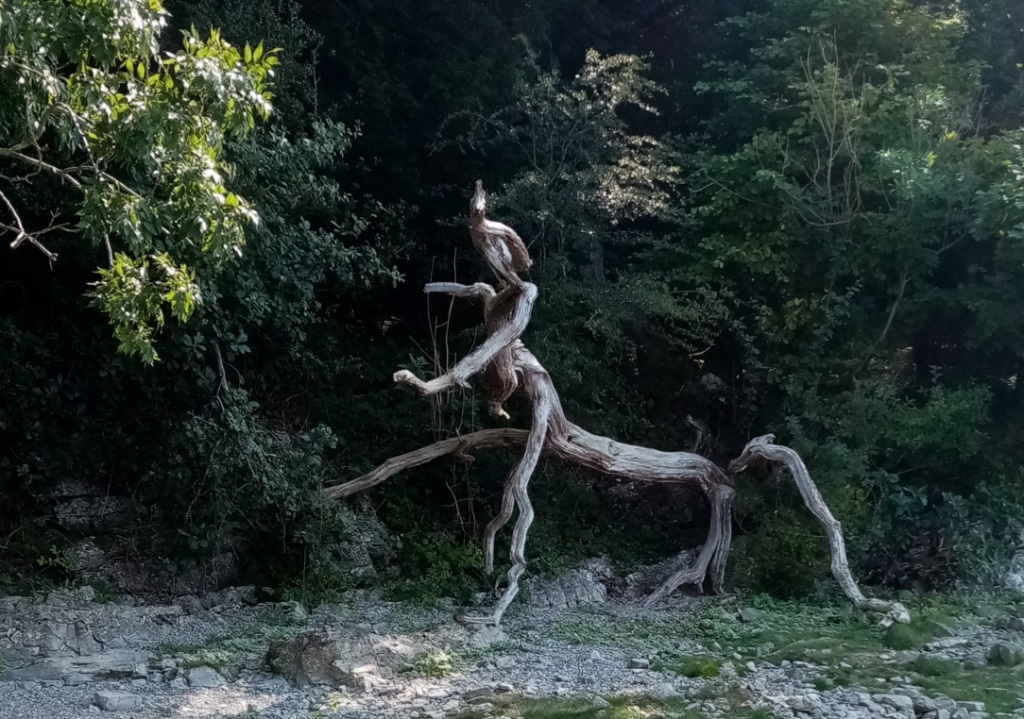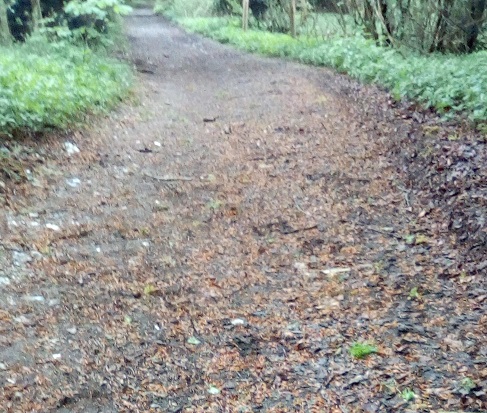
I think it’s a centaur, stepping out from the trees beside Morcambe Bay. Thank goodness no-one has seen fit to remove it as a public safety measure.


A reminder of what May looks like! I found this picture of the inviting Worth Way in Sussex as I was reorganising files to set up the new computer. I enjoyed this ride over former rail lines and quiet roads, despite facing determined lycra clad racing cyclists going the opposite way on the road! My trusty Brompton refuses to be a townee bike!

Abel’s legs are getting longer and stronger, so that he can soon get out of sight in Larkey Valley Woods. (These were given to the people of Canterbury by a former Mayor, Frank Hooker.)
Abel’s gone while I was telling you that! At least he has got the idea of following the waymark arrows but – the red and blue diverge ahead and we forgot to put his hi-vis jacket on. But he’s hiding somewhere …
Where’s my Grannie?
Well, you see why I only got one photo on this walk.
Spring is as active as Abel, and the green flowers of the spurge stood out against the dark leaves and shadow behind them. I once had a teacher who said there were no green flowers – she’d probably call them yellow, just to avoid being proven wrong!

Yesterday Abel was coming away from the L’Arche Glebe garden when his eye was arrested by the round, tan-coloured husks beneath the hollow yew outside Saint Mildred’s church. They must really be discarded cones, since the yew is a conifer – with no recognisable cone.
I was half reminded of something. Then today Mrs T and I went to see the cowslips near Brogdale, happily growing on the chalk. Another chalk-lover is the beech tree, one I loved to climb as a boy, and a mile or so on from the cowslip field our walk took us through a beech wood. Unlike this picture from last year, it was a grey day, the path was wet, but we could still appreciate Edward Thomas’s observation in The South Country.
Then in the early morning the air is still and warm, but so moist that there is a soul of coolness in the heat, and never before were the leaves of the sorrel and wood sanicle and woodruff, and the grey-green foliage and pallid yellow flowers of the large celandine, so fair. The sudden wren’s song is shrewd and sweet and banishes heaviness. The huge chestnut tree is flowering and full of bees. The parsley towers delicately in bloom. The beech boughs are encased in gliding crystal. The nettles, the millions of nettles in a bed, begin to smell of summer. In the calm and sweet air the turtle-doves murmur and the blackbirds sing — as if time were no more — over the mere.
The roads, nearly dry again, are now at their best, cool and yet luminous, and at their edges coloured rosy or golden brown by the sheddings of the beeches, those gloves out of which the leaves have forced their way, pinched and crumpled by the confinement. At the bend of a broad road descending under beeches these parallel lines of ruddy chaff give to two or three days in the year a special and exquisite loveliness, if the weather be alternately wet and bright and the long white roads and virgin beeches are a temptation.

There is never enough traffic on this bridleway to order the husks into parallel lines, but there they are, colouring the path. The nettles are in evidence ahead; we would discern the white of cow parsley if we were closer, but the pale celandine was not yet in flower here. (The bright, low-growing, lesser celandine is all but finished.)

Close to, the russet husks are indeed cool and luminous. Who would have said that brown could shine?
Thank you Edward Thomas!


Mrs T and I went to London to help George extract a tree stump and lay down a lawn.
Just across the road was a gateway into an urban woodland, a cemetery abandoned for half a century. No time to do more than take a quick peek but the trees were starting into leaf and blossom, the bluebells and other Spring flowers were inviting smiles from the walkers and cyclists enjoying the woods.
Read more about the park by following the link: Tower Hamlets Cemetery Park

I hope you have an oasis near you, and are enjoying the Spring, if you are in the Northern hemisphere!

One thing lead to another, and with A busy Easter, and then being in a city, we did not manage our garlic forage until today. A new spot that Mrs T had found the other day. Flowers were shining among the leaves here and there.

But the surprise of the day was to discover a pheasant’s nest with a good dozen eggs in it. The cock was quite agitated not far away, no doubt his wife, too, was watching us. We gathered our leaves as quickly as possible and left them in peace. 8 jars of pesto are our reward!


I’d guess that WH Davies had a reason for calling his most familiar poem ‘Leisure’. Although it has been holiday time the days and evenings have been full, yet there have been moments, every day, to stop and stare: yesterday to marvel at a thrush singing each song twice over, and to hear how he had orchestrated a vehicle reversing alarm and a common telephone ring into his song. That fulfilled this verse:
No time to stand beneath the boughs
And stare as long as sheep or cows.
And coming down Abbot’s Hill the other day, I saw a squirrel digging for nuts, which recalls:
No time to see, when woods we pass,
Where squirrels hide their nuts in grass.
Bring Spring on! Here’s the poem:
What is this life if, full of care,
We have no time to stand and stare.No time to stand beneath the boughs
And stare as long as sheep or cows.No time to see, when woods we pass,
Where squirrels hide their nuts in grass.No time to see, in broad daylight,
Streams full of stars, like skies at night.No time to turn at Beauty’s glance,
And watch her feet, how they can dance.No time to wait till her mouth can
Enrich that smile her eyes began.A poor life this is if, full of care,
We have no time to stand and stare.

Advancing age inspires caution when tackling physical tasks. I first observed this as a teenager, working in the local park. The old guys, as we thought of them, got as much and more than we did in the day with less effort. They weren’t afraid of work; most of them had been miners, but knew how to look after themselves as they worked.
So I try to plan jobs to take account of my aches and pains. Now, though, it is important to remember Robin, who takes great interest in whatever we are doing. Today it was stacking logs, just delivered from the orchard, to keep us going through the winter.
For Robin the logs were a source of dainties. After a year or two’s seasoning they had a population of woodlice, worms and other creatures, some of which were disturbed as I moved the logs, only to be pounced on by this miniature bird of prey.
We managed to work alongside each other very successfully. I’m sure he’s as good as any young Robin can be at self-preservation.

A walk in the woods with Abel, now 16 months old, is another story. I’d greet all the dogs as a matter of course, but he enjoys them to the point of bubbling with laughter; there is disappointment that the brambles are now bare of blackberries, but even so he (and I) appreciate the seasons; puddles are for throwing stones into and exclaiming ‘splash’, or as near as we can get, while a big pine tree is for hide and seek. Happy Days.